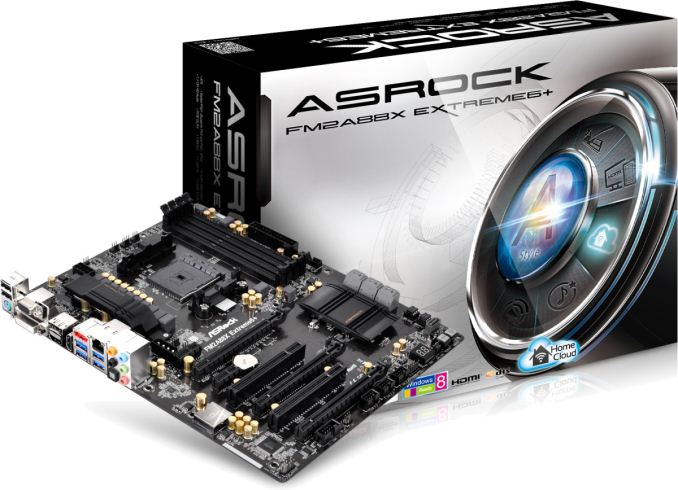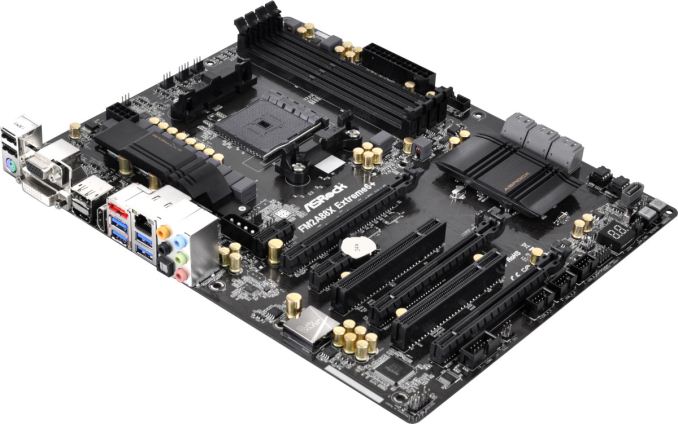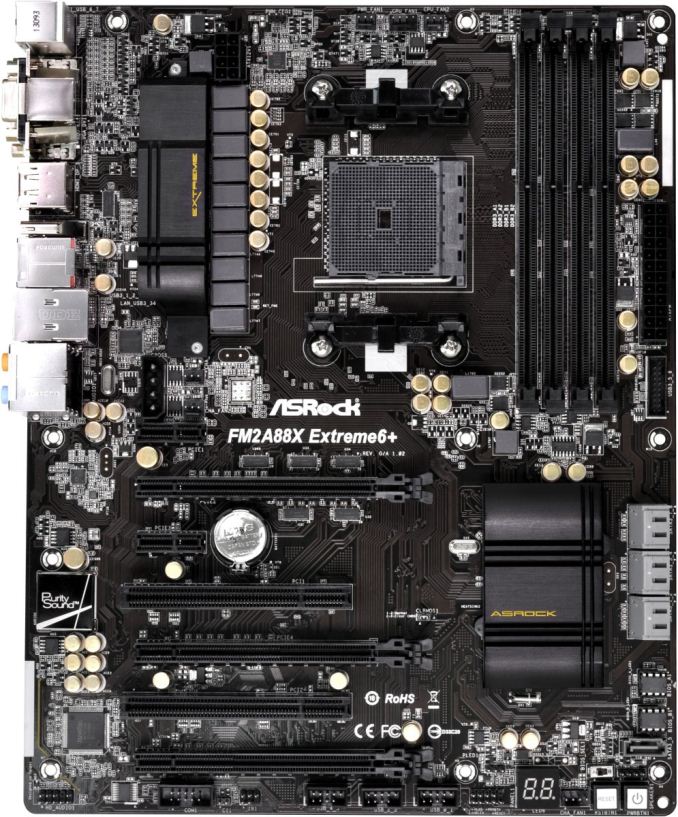ASRock FM2A88X Extreme6+ Review
by Ian Cutress on March 19, 2014 11:59 AM EST
For the
ASRock FM2A88X Extreme6+ Overview
The AMD Kaveri launch was a bit of a mêlée – two weeks to test a dozen processors in our new benchmarking suite, both in terms of CPU and IGP performance, with the big write up at the end. At the time I used the FM2A88X Extreme6+ motherboard, and in order to avoid complications I put on some rock solid air cooling and it sailed through the process. When I removed the extra cooling, a heat-related issue started to occur. I noticed the VRM heatsink getting hot, and as a result the system was reducing frequencies after extended workloads. After checking everything in the software side was OK, I got an infrared thermometer to probe some of the components. When the VRM heatsink showed 88C after 5 minutes of encoding work, and 97C after an hour, I had found the culprit of the issue. 88C is a rather high temperature, despite these components are usually rated to 105C. Since I finished testing the motherboard, ASRock has launched several new BIOSes, which I tested after consulting ASRock. The final result was that the system till reached 80C after 10-15 minutes of hard CPU work (normal work rather than a power virus) and 92C after 25+ minutes.
This might be seen a stern start to a motherboard review, especially one that has won awards elsewhere and performed well in our high-end air cooled testing. The FM2A88X Extreme6+ is a full sized ATX motherboard using the A88X chipset, supplanted with an 8+2 power phase design. From the chipset we have eight SATA 6 Gbps ports (7 regular + 1 eSATA), 6 USB 3.0 ports, an x8/x8 + x4 PCIe layout and support for up to 64GB DRAM from four memory slots. ASRock's website states that this motherboard can be part of a system that supports 4096x2400 at 60 Hz via DP 1.2. Other video outputs are present as well (VGA, DVI-D and HDMI).
ASRock’s additions to the base chipset include support up to DDR3-2600 on the memory, a Realtek ALC1150 audio codec (rated at 115dB SNR) with a TI NE5532 headset amplifier, a Qualcomm Atheros AR8171 network interface, six fan headers, power/reset buttons, a two digit debug, an ASMedia ASM1042 for two additional USB 3.0 ports and the ASRock BIOS/Software ecosystem that is ever improving.
In our performance testing, the motherboard and CPU combination trades blows with another FM2+ motherboard we are currently testing, winning in a few CPU and gaming tests. The system scores under 10 seconds for a Windows 7 POST time, although the DPC Latency is matching that of our Intel 8-series results oddly enough.
ASRock is often very aggressive on pricing, and the FM2A88X Extreme6+ comes in at $105, near other motherboards from ASUS, GIGABYTE and MSI. ASRock is continually building an ecosystem around the BIOS utilization and software functionality in order to make their products more desirable, though additional cooling on this model might be recommended.
Visual Inspection
ASRock’s 2013 livery moves to 2014 with the higher end chipset SKUs bathed in black and gold colors – the FM2A88X Extreme6+ is no exception.
The socket area has no obvious outline, but opens up the AMD socket to large coolers in all directions. The power delivery to the left of the socket gives the 8+2 configuration, although the heatsink provided is quite small with no extension or additional fan. There are five fan headers around the socket, three above (CPU 4-pin, CPU 3-pin and PWR 3-pin) and two underneath the power heatsink, both CHA 3-pin. The final fan header on the motherboard is a CHA 4-pin in the bottom right.
Moving clockwise around the motherboard, the DRAM slots are double ended latch mechanisms, although they use the thinner latches with a full sized slot. Underneath the 24-pin ATX power connector is a USB 3.0 port, followed by six of the SATA 6 Gbps ports. ASRock provides two BIOSes on the Extreme6+, both replaceable should one fail. Next follows another SATA 6 Gbps port and a BIOS selector switch.
The chipset heatsink is small to cater for the A88X chipset (~7W). The sole additional controller on the motherboard is an ASMedia ASM1042 – a USB 3.0 controller near the rear IO that does not need a heatsink.
The PCIe layout uses two PCIe 2.0 x1 small slots, two PCI slots, two PCIe 3.0 slots (in either x16/- or x8/x8 mode) and a final PCIe 2.0 x4 slot from the chipset. This final slot is designed for other non-gaming GPU PCIe devices, although it can be used for 3-way CrossFire at a lower-than expected scaling rate. For users wanting to put three power-hungry devices into the full length PCIe slots, ASRock provides a 4-pin molex connector for extra power. In my opinion, the location of this connector is frustrating, requiring cables to reach over the motherboard. Other manufacturers have utilized SATA power, or 6-pin PCIe connector, at the edge of the motherboard. This is a preferred location, as it does not require cables reaching across the system.
On the bottom of the board we have a good combination of power and reset buttons coupled with a two-digit debug LED. If I had my way, these would be on all motherboards to help with debugging issues. Also present are three USB 2.0 headers, a COM header, a Front Panel audio header, a front panel header and one of the aforementioned fan headers.
ASRock’s Purity Sound paradigm on the audio consists of a Realtek ALC1150 audio codec in an EMI shield, filter caps, a headphone amplifier and ASRock also list PCB shielding to help improve the audio signal.
The rear IO of the motherboard consists of two USB 2.0 ports, a PS/2 combination port, VGA, dual-link DVI-D, a DisplayPort, a HDMI-out, a HDMI-in, an eSATA 6 Gbps (A88X), two USB 3.0 ports (A88X), two more USB 3.0 ports (ASMedia ASM1042), an Ethernet port (Atheros AR8171), an optical SPDIF output and audio jacks.
Board Features
| ASRock FM2A88X Extreme6+ | |
| Price | Link |
| Size | ATX |
| CPU Interface | FM2+ |
| Chipset | AMD A88X (Bolton D4) |
| Memory Slots |
Four DDR3 DIMM slots supporting up to 64 GB Up to Dual Channel, 1333-2600 MHz 2600 MHz with two modules |
| Video Outputs |
HDMI at 4096x2160 (24 Hz) DVI-D at 2560x1600 (60 Hz) D-Sub at 1920x1200 (60 Hz) DisplayPort at 4096x2400 (60 Hz) or 4096x2160 (60 Hz) |
| Onboard LAN | Qualcomm Atheros AR8171 |
| Onboard Audio | Realtek ALC1150 |
| Expansion Slots |
2 x PCIe 3.0 x16 (x16, x8/x8) 1 x PCIe 2.0 x4 (A88X) 2 x PCIe 2.0 x1 2 x PCI |
| Onboard SATA/RAID |
7 x SATA 6 Gbps (A88X), RAID 0, 1, 5, 10 1 x eSATA 6 Gbps (A88X) |
| USB 3.0 |
4 x USB 3.0 (A88X) [2 back panel, 1 header] 2 x USB 3.0 (ASMedia ASM1042) [2 back panel] |
| Onboard |
7 x SATA 6 Gbps 1 x USB 3.0 Header 3 x USB 2.0 Headers 6 x Fan Headers 1 x Front Panel Audio Header 1 x COM Header Power/Reset Switches BIOS Selection Switch Two-Digit Debug LED |
| Power Connectors |
1 x 24-pin ATX Power Connector 1 x 8-pin CPU Power Connector 1 x 4-pin Molex VGA Power Connector |
| Fan Headers |
2 x CPU (4-pin, 3-pin) 3 x CHA (4-pin, 2 x 3-pin) 1 x PWR (3-pin) |
| IO Panel |
PS/2 Combination Port D-Sub HDMI In HDMI Out DVI-D DisplayPort Optical SPDIF Output 2 x USB 2.0 Ports 2 x USB 3.0 Ports (A88X) 2 x USB 3.0 Ports (ASMedia) 1 x GbE LAN (AR8171) 1 x eSATA 6 Gbps (A88X) Audio Jacks |
| Warranty Period | 3 Years |
| Product Page | Link |
The addition of a USB 3.0 controller and a high-end Realtek audio codec puts the Extreme6+ high up the product stack for an AMD FM2+ motherboard. Unlike Intel were a $400 motherboard might be common, motherboard manufacturers tend not to splash out on an AMD motherboard (with PCIe PLX switches or obscure lane allocations) purely due to demand and volume.














44 Comments
View All Comments
niva - Wednesday, March 19, 2014 - link
These benchmarks are making me depressed for AMD CPUs. I guess it's time to switch to Intel after not having purchased an Intel chip since 1996.nathanddrews - Wednesday, March 19, 2014 - link
Come on in, the water's fine.Malorcus - Wednesday, March 19, 2014 - link
I hear you man, I did the same with my current Ive Bridge CPU. I am looking to build a media computer using an AMD APU though. They still have their niche, but it is not in high end computing/gaming.ddriver - Wednesday, March 19, 2014 - link
You'd be surprised by the amount of needed and commercially viable tasks for which those poor CPUs are more than fast enough. It is a sad thing to see AMD struggling to compete with Intel's value products.Fallen Kell - Thursday, March 20, 2014 - link
AMD has sadly not had a real competing product in the high end side for 6 or 7 years now. On the low end, AMD was competing, until Intel decided to compete in this market segment. The last two updates that Intel has made were more focused on the lower end than on the high end. This is finally cutting into the one thing keeping AMD alive. I really hope AMD does survive because those of us that are old enough to remember know that Intel hates the consumer and only really pushes technology when it is competing. We would have CPU's that are only soldered directly into motherboards with no ability to upgrade, completely locked down CPUs with no ability to overclock, locked in memory bus speeds that are tiered based on the CPU/motherboard that you purchased with higher performance memory compatibility costing you extra, etc., etc....But I really don't see a way that AMD can compete at this point. They are still hemorrhaging money (not nearly as bad as a year ago when they lost $1.2 BILLION, but even after restructuring to cut 31% of their operating costs, they still lost $162 million last year). While I understood the reason for acquiring ATI, I believe ATI is worse off due to that acquisition. ATI went from being a profitable company competing well in their market, to one that is losing money and is seemingly almost a generation behind Nvidia in their offerings (I say this based on the fact that the brand new released top of the line AMD graphics cards can barely beat the last generation of cards from Nvidia in performance and can not come anywhere near the Nvidia offerings in power/performance or heat/performance, and Nvidia is getting ready to release its true next generation of cards even while they simply released the last generation of cards at their full potential to beat AMD's current cards now that AMD finally had a competing product). The major losses that AMD as a whole has, is taking its toll on the R&D AMD can afford to do in terms of increasing the efficiency of their designed with respect to power and cooling requirements while still being able to push the performance of their cards.
Demiurge - Friday, March 21, 2014 - link
Funny, I thought the same thing about Intel CPU's when GPU's started to encroach on the high performance features such as physics, ray-tracing, signal processing, and other high intensity applications. There's a bigger picture that I think a lot of people miss. The market has already shifted away from CPU's being the centerpiece of high performance applications. AMD has the right strategy with buying ATI and the paradigm of Heterogeneous Computing, but like Intel with the P4: it's too little too late. If they had the software, they might've been able to pull this off, but that is exactly what they are trying to do with Mantle. I think only unanimous adoption would've guaranteed a win. It was a big risk, and it would have been an amazing upstart, but I don't think it will pay off as much as they need it to. Just a modest opinion... and so a long rant ends... ;-)pandemonium - Thursday, March 20, 2014 - link
AMD hasn't been competitive to Intel for the consumer since 1999 or so? They've always been cheaper, and always been far lower in gaming and general desktop usage results as well. You are very, very, very late to the party, lol.mr_tawan - Thursday, March 20, 2014 - link
I believe it was Intel Core series (2006) that started to get ahead of AMD's CPU. Before that, AMD CPUs was both perform better and cheaper. Intel CPUs were power hungry and expensive while did not yield excellent performance.The raw ALU performance on the current line of AMD CPU is quite low because of the design decision to reduce the space occupied by the CPU while add even more GPU on the die, and then make them work together more nicely. It's the direction the AMD heads to.
I believe that one day even the FX line would be APU just like those A-series.
Vinny DePaul - Thursday, March 20, 2014 - link
I feel your pain. I am an AMD fan. I want to keep using AMD but the CPU is running too hot. It is heating up the room! I switch to Intel. It is just easier.... I hope the AMD's involvement in PS4 and Xbox One will shape the future in games and software.Xpl1c1t - Thursday, March 20, 2014 - link
This is exactly what I did going from a Athlon XP Palomino, to Athlon 64 Venice, to a Core i5 Lynnfield.I'd consider purchasing an AMD processor again if the whole APU thing becomes quite competent and powerful at a smaller and more efficient node. I'd promptly and gladly buy an APU with the equivalent of 2 IVB cores and a 7870 onboard if it could me mounted on a Pico-ITX board...